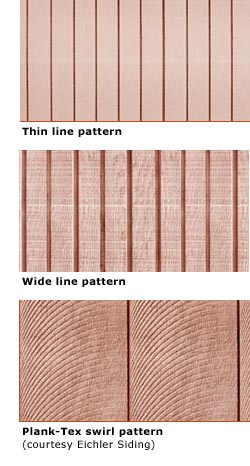Eichler Exterior Siding
 One of the most striking aspects of the Eichler homes is the attractive exterior siding that Joe Eichler incorporated in his home designs. Rather than using the standard plywood patterns of his day, Eichler created his own.
One of the most striking aspects of the Eichler homes is the attractive exterior siding that Joe Eichler incorporated in his home designs. Rather than using the standard plywood patterns of his day, Eichler created his own.
There are various stories of why and how Eichler produced his own siding, but the result was a series of patterns that for the most part are unique to Eichler homes. Though siding with Eichler patterns is no longer available in lumberyards, supplies for homeowners do exist within the Bay Area Eichler communities.
In his early homes, Eichler incorporated horizontally oriented siding, but by the mid-1950s he switched, with rare exceptions, to patterns with vertical grooves placed close together to more suitably complement his modern designs. Instead of using horizontal-lapped siding, which is more common today, he used plywood siding to create his unique patterns. The one exception was 'Plank-Tex,' a swirl-pattern design manufactured by U.S. Plywood. Not unique to Eichler homes, Plank-Tex can be found today on Eichlers in Foster City, Lucas Valley, and several other mid-'60s developments.
These three patterns are the most common siding styles found in Eichler tracts. However, there are a few exceptions, and these variations would likely require the expertise of a custom miller. With a little patience and a tape measure, it is easy to determine which siding pattern lines your Eichler's exterior. First, measure from the center of one vertical groove to the center of the very next one. This measurement is one that is 'on center.' Depending on your particular pattern, you will typically find on-center measurements of one-and-5/8 inches, two inches, or eight inches.

Next, measure the actual width of the groove, which is the channel that is cut below the surface of the wood. Typical Eichler grooves measure 1/8 inch, 3/8 inch, or 1/4 inch in width. So, having done this, you now have two important measurements: your 'on center' distance and the width of the groove. Before placing your siding order, also determine the thickness of your home's siding. This can be tricky because many layers of paint may be present to pad the true measurement. But for the most exact measuring point, try the edge at the bottom of the siding. Most siding is 3/8 inch, 1/2 inch, or 5/8 inch thickness.
Unfortunately, consistency of siding thickness was not the norm in Eichler tracts. Thicknesses may vary from one pattern to another within a particular tract, and one pattern in one development may differ in thickness from the very same pattern in another tract. With that in mind, accurately measuring the thickness of your present siding becomes a critical step.
If the siding you order turns out to be slightly undersized in thickness, an installer can account for this difference by adding furring strips to the top of the studs. While this furring method is not preferred over replacing the old siding with an exact thickness match, it will allow the new sheets to be installed flush with the old ones. However, care must be taken when using furring strips; the nail length should be increased to ensure that the siding remains firmly against the stud. If you are unsure of your siding thickness, especially when approaching a do-it-yourself installation, defer to your siding supplier or an experienced installer or contractor.
As you enter your siding repair or replacement project, it also will be necessary to determine the overall size of the needed panel or panels. The panel height may be eight, nine, or ten feet—or perhaps even measure somewhere in between these increments. Since plywood is now manufactured in standard 48-inch widths, this is the maximum width measurement available. The installer can best determine the exact amount of siding needed for your project. While one does not want to purchase too much, you still need enough siding to complete the job while compensating for the various siding widths that Eichler originally used. Another important issue is the actual texture and grades of the siding. Original Eichler siding was milled from plywood that was semi-smooth, exposing the natural wood grain. Without getting too technical, suffice it to say that today the choices of plywood textures and grades are limited. Some early Eichler homes used redwood plywood. Today, redwood plywood is almost impossible to acquire, and if found, is costly. In general, the choices presently are Douglas fir, and mahogany that is sold under the brand name of 'Breckenridge.'




